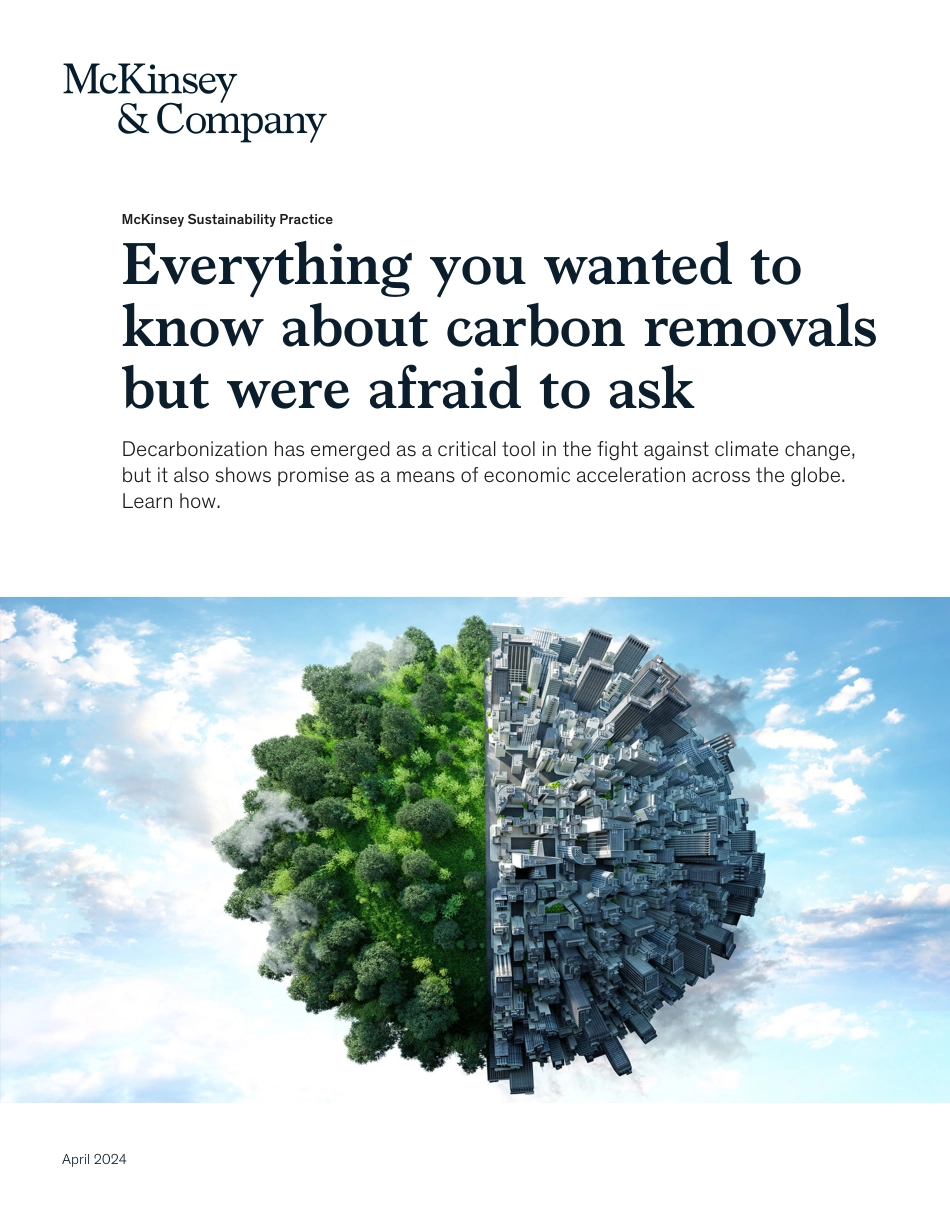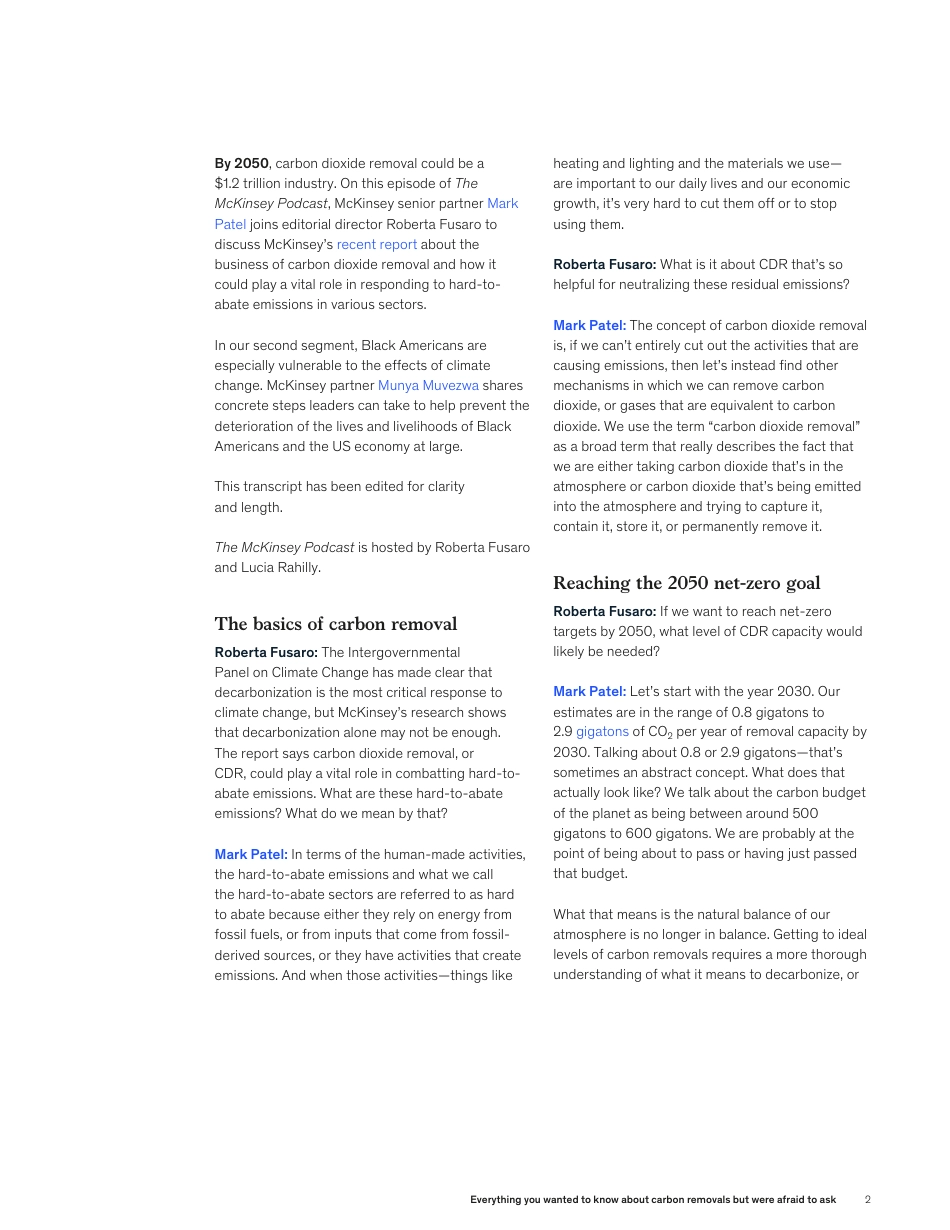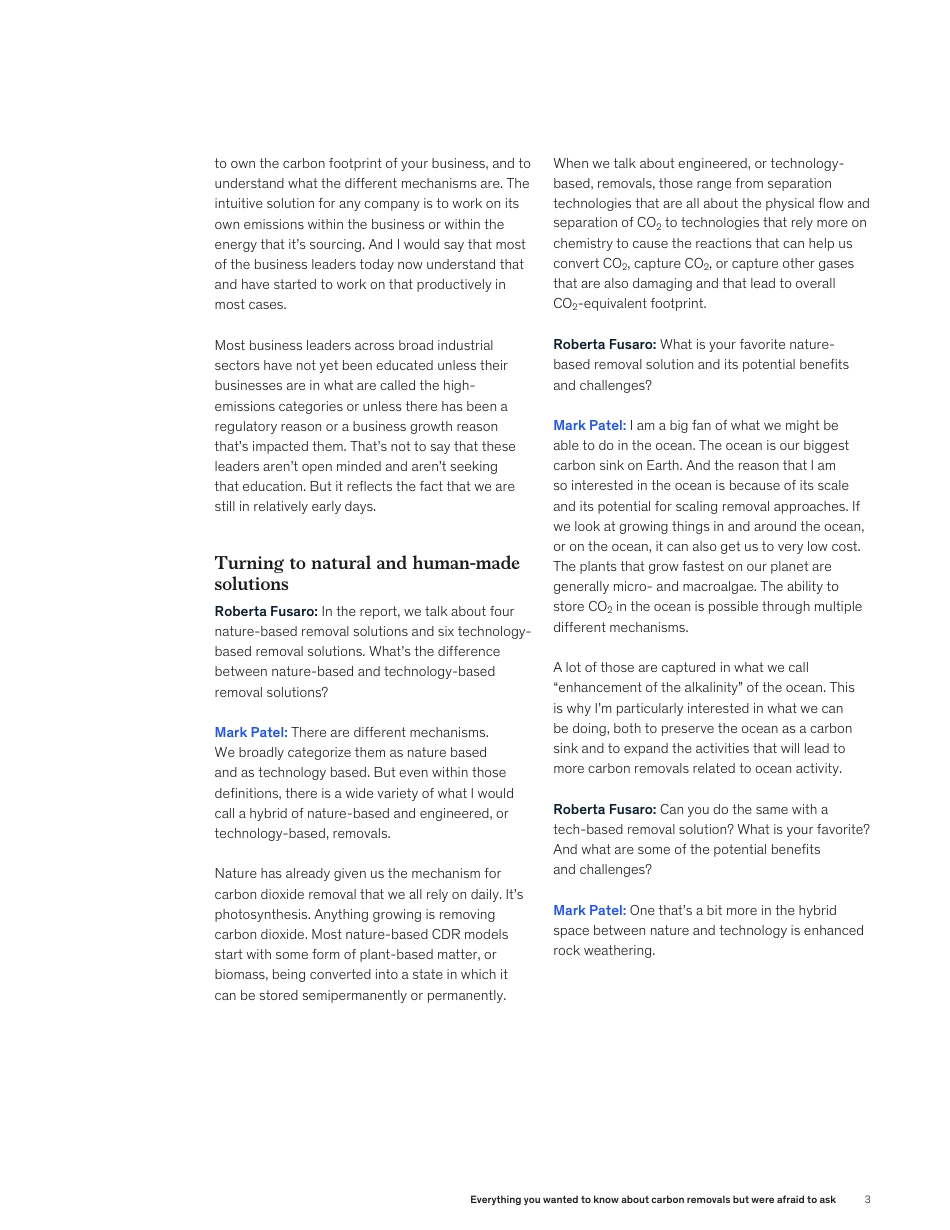McKinseySustainabilityPracticeEverythingyouwantedtoknowaboutcarbonremovalsbutwereafraidtoaskDecarbonizationhasemergedasacriticaltoolinthefightagainstclimatechange,butitalsoshowspromiseasameansofeconomicaccelerationacrosstheglobe.Learnhow.April2024By2050,carbondioxideremovalcouldbea$1.2trillionindustry.OnthisepisodeofTheMcKinseyPodcast,McKinseyseniorpartnerMarkPateljoinseditorialdirectorRobertaFusarotodiscussMcKinsey’srecentreportaboutthebusinessofcarbondioxideremovalandhowitcouldplayavitalroleinrespondingtohard-to-abateemissionsinvarioussectors.Inoursecondsegment,BlackAmericansareespeciallyvulnerabletotheeffectsofclimatechange.McKinseypartnerMunyaMuvezwasharesconcretestepsleaderscantaketohelppreventthedeteriorationofthelivesandlivelihoodsofBlackAmericansandtheUSeconomyatlarge.Thistranscripthasbeeneditedforclarityandlength.TheMcKinseyPodcastishostedbyRobertaFusaroandLuciaRahilly.ThebasicsofcarbonremovalRobertaFusaro:TheIntergovernmentalPanelonClimateChangehasmadeclearthatdecarbonizationisthemostcriticalresponsetoclimatechange,butMcKinsey’sresearchshowsthatdecarbonizationalonemaynotbeenough.Thereportsayscarbondioxideremoval,orCDR,couldplayavitalroleincombattinghard-to-abateemissions.Whatarethesehard-to-abateemissions?Whatdowemeanbythat?MarkPatel:Intermsofthehuman-madeactivities,thehard-to-abateemissionsandwhatwecallthehard-to-abatesectorsarereferredtoashardtoabatebecauseeithertheyrelyonenergyfromfossilfuels,orfrominputsthatcomefromfossil-derivedsources,ortheyhaveactivitiesthatcreateemissions.Andwhenthoseactivities—thingslikeheatingandlightingandthematerialsweuse—areimportanttoourdailylivesandoureconomicgrowth,it’sveryhardtocutthemoffortostopusingthem.RobertaFusaro:WhatisitaboutCDRthat’ssohelpfulforneutralizingtheseresidualemissions?MarkPatel:Theconceptofcarbondioxideremovalis,ifwecan’tentirelycutouttheactivitiesthatarecausingemissions,thenlet’sinsteadfindothermechanismsinwhichwecanremovecarbondioxide,orgasesthatareequivalenttocarbondioxide.Weusetheterm“carbondioxideremoval”asabroadtermthatreallydescribesthefactthatweareeithertakingcarbondioxidethat’sintheatmosphereorcarbondioxidethat’sbeingemittedintotheatmosphereandtryingtocaptureit,containit,storeit,orpermanentlyremoveit.Reachingthe2050net-zerogoalRobertaFusaro:Ifwewanttoreachnet-zerotargetsby2050,whatlevelofCDRcapacitywouldlikelybeneeded?MarkPatel:Let’sstartwiththeyear2030.Ourestimatesareintherangeof0.8gigatonsto2.9gigatonsofCO2peryearofremovalcapacityby2030.Talkingabout0.8or2.9gigatons—that’ssometimesanabstractconcept.Whatdoesthatactuallylooklike?Wetalkaboutthecarbonbudgetoftheplanetasbeingbetweenaround500gigatonsto600gigatons.Weareprobablyatthepointofbeingabouttopassorhavingjustpassedthatbudget.Whatthatmeansisthenaturalbalanceofouratmosphereisnolongerinbalance.Gettingtoideallevelsofcarbonremovalsrequiresamorethoroughunderstandingofwhatitmeanstodecarbonize,orEverythingyouwantedtoknowaboutcarbonremovalsbutwereafraidtoask2toownthecarbonfootprintofyourbusiness,andtounderstandwhatthedifferentmechanismsare.Theintuitivesolutionforanycompanyistoworkonitsownemissionswithinthebusinessorwithintheenergythatit’ssourcing.AndIwouldsaythatmostofthebusinessleaderstodaynowunderstandthatandhavestartedtoworkonthatproductivelyinmostcases.Mostbusinessleadersacrossbroadindustrialsectorshavenotyetbeeneducatedunlesstheirbusin...



 VIP
VIP VIP
VIP VIP
VIP VIP
VIP VIP
VIP VIP
VIP VIP
VIP VIP
VIP VIP
VIP VIP
VIP